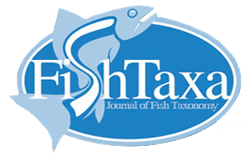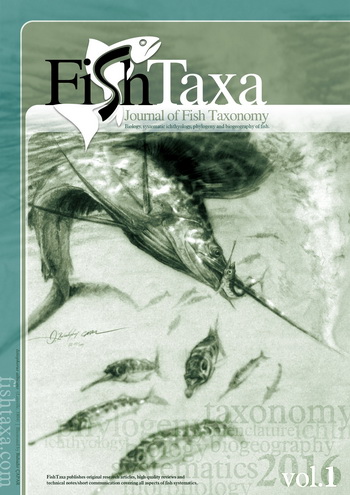Goatfishes of the world: An updated list of taxonomy, distribution and conservation status (Teleostei: Mullidae)
Sorour ECHRESHAVI, Hamid Reza ESMAEILI
Ichthyology and Molecular Systematics Research Laboratory, Zoology Section, Department of Biology, School of Science, Shiraz University, Shiraz, Iran
Saud M. AL JUFAILI
Department of Marine Science and Fisheries, Sultan Qaboos University, P.O Box 34 Al Khod 123 Muscat, Oman
Abstract
Members of the Mullidae family are characterized by body elongate and almost compressed, head and body completely scaled (except the periorbital region of some Upeneus), with 27 to 39 vertical scale rows from the upper end of gill opening to the base of caudal fin; chin with 2 long hyoid barbels; opercle usually with a small flat spine; two well-separated dorsal fin and 24 vertebrae. They inhabit brackish and marine waters above sandy to muddy bottoms as well as coral reefs. Mullids are distributed worldwide in tropical, subtropical, and temperate habitats of the Mediterranean and the Black Sea, Pacific and the Atlantic Ocean, southern and eastern Australia, and New Zealand between the upper littoral and the upper slope. This checklist aims to list all the valid Mullidae fishes of the world. It lists 101 species in 6 genera. The most diverse genus is Upeneus (48 species, 47%), followed by Parupeneus (35 species, 35%), Mulloidichthys (7 species, 7%); Mullus (6 species 6%); Pseudupeneus (3 species, 3%), and Upeneichthys (2 species, 2%). For this genus, several taxonomic species groups, including moluccensis, margarethae, stenopsis, japonicus, suahelicus, and tragula have been proposed. Some of the species are still ungrouped. The high inter-and intraspecific phenotypic diversity among the genus Upeneus requires a careful taxonomic approach regarding both species diagnoses and descriptions, re-descriptions, resurrections, or synonomizations. Among 101 listed species, 54 (55%) species are Least Concern (LC), 36 (36%) species are Not Evaluated (NE), 6 (6%) species are Data Deficient (DD), 1 (1%) species are Vulnerable (VU), 1 (1%) species are Near Threatened (NT) and 1 (1%) species are Endangered (EN) of the Red List of IUCN. Some of the less-known species, or species from less explored areas, merit more attention and approval of a similar fine-resolution taxonomy approach, ideally accompanied by comprehensive integrative molecular studies, to more completely understand the overall diversity, the speciation events, and the evolutionary pathways involved in mullids.

